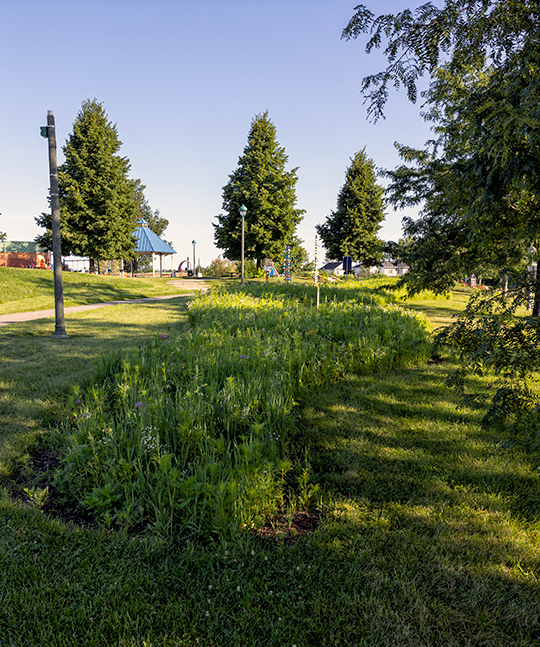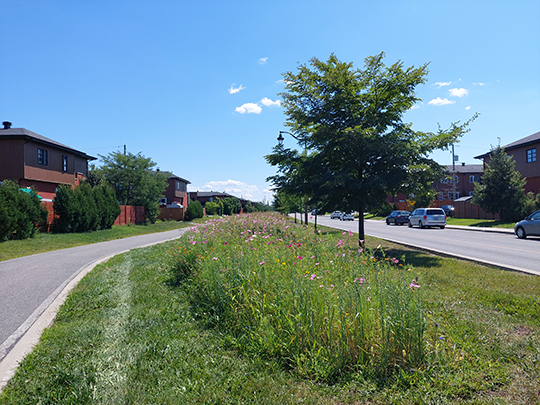Biodiversity islands
The City of Vaudreuil-Dorion has a pilot project to propose this summer, offering citizens the possibility of using an environmentally friendly method to manage their lawns. The same type of landscaping approach is also be implemented on certain municipal lots.
This pilot project involves allowing residents of Vaudreuil-Dorion to let vegetation grow on a section of their property (front, back or side yard) beyond a height of 30 cm in order to favour the establishment of indigenous flowers and grasses, increase urban biodiversity, and promote the presence of pollinator insects, all while respecting the standards and criteria that have been set pertaining to maintenance.
Setting up a biodiversity island can be achieved by allowing grassy vegetation to grow naturally, by sowing a mixture of flowers, or by adding mature indigenous plants. To maintain such an island, you simply need to mow the lawn surrounding it to clearly delineate the area and control the growth of unwanted plant species. Caution! This is not about neglecting the property, but rather managing part of an urban plot of land using an ecological approach.
The project is split into two components: Residential and municipal.
Residential component
The residential component aims to allow a limited number of single-family homeowners throughout the territory to let grassy vegetation grow on their property as a means to create biodiversity islands for pollinators.
To participate, residents must adhere to certain pre-established criteria to ensure they do not compromise safety and social cohesion. Environmental awareness agents will inspect the property of participating citizens during the summer to ensure compliance with these criteria and assist citizens as needed.
Criteria:
- Keep a clear strip of land measuring 2 metres along public roadways, bicycle paths and private entrances.
- Keep a clear strip of land measuring 2 metres around all buildings, with the exception of flowerbeds.
- Keep a clear strip of land measuring 2 metres along property lines.
- Keep a clear strip of land measuring 3 metres around any combustion appliance (outdoor conventional or fuel-operated fireplace, outdoor cooking appliance running on charcoal, propane, or gas).
- Biodiversity islands must not obstruct road signs or the building’s civic number.
- For corner lots, the vegetation located within the visibility triangle must be less than 0.9 metres tall.
Conditions:
- Plants that are harmful to health or pose a risk to the environment must be controlled to limit their spread (ragweed, poison ivy, giant hogweed, common reed, Japanese knotweed, etc.). They should be disposed of in the garbage in a sturdy bag to prevent spread.
Three ways to create and maintain a biodiversity island
Biodiversity islands can take many different forms, and there are a number of techniques available for creating them. In all cases, it will be necessary to mow the vegetation in autumn to allow it to regrow the following spring, and to avoid the establishment of woody plants such as trees and shrubs.
- Letting vegetation grow naturally: A first option for creating an island of biodiversity is to stop mowing the vegetation on an area of land, allowing the seeds already present in the soil to grow. In the first year of the project, the biodiversity island will be composed mainly of grasses such as turf, which will give way to other herbaceous plants over time. To maintain this biodiversity island, simply mow the surrounding lawn to define the chosen area and control undesirable plant species.
- Sow a mixture of flowers: A second option is to sow a mixture of meadow flowers to create an island of colourful, flowering biodiversity more quickly. To do this, simply broadcast a seed mixture between mid-May and mid-June. To encourage germination, we recommend lightly tilling the soil and spreading a thin layer of compost over the lawn with a rake before sowing. To reduce the presence of grasses, it is also possible to completely remove the lawn from the desired area before spreading loam and sowing.
- Plant mature melliferous native plants: A final option for creating an island of biodiversity is to put mature native flowering plants in the ground for quick results. Several plants can be selected, such as yarrow, common milkweed, New England aster, goldenrod or bipinnate cosmos. Planted in spring, these perennials or annuals will produce a seed bank in the soil that will regrow the following year.
To participate
Citizens wishing to set up a biodiversity island on their property are invited to fill out this form and send it to the Environment Division between April 1st and 30th. Their eligibility will be confirmed by a member of the Environment Division during the first week of May. Participation in the biodiversity island pilot project is valid for one year. Eligibility for subsequent years must be reassessed annually, should the project be renewed.
Each participant will receive a poster to identify the island as well as a bag of wildflower seeds, until all available seeds are used up.
For more information: 450 455-3371 or environnement@ville.vaudreuil-dorion.qc.ca
The Butterflyway Project’s local citizen association also regularly disseminates information on pollinator-friendly developments.
Example of a residential biodiversity island

Municipal component
Sample islands will be set up throughout the City to raise awareness among residents about pollinator protection and to promote the different techniques for initiating similar biodiversity areas. The sites selected for the project include the following locations:
- Municipal building, 51 Jeannotte
- Parc de la Canardière
- Parc-nature Harwood
- Grassy area on Avenue André-Chartrand
- Parc Aurèle-Joliat




